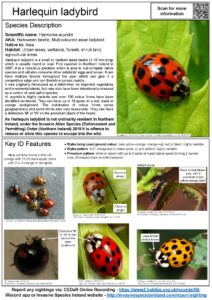Harlequin ladybird
Harmonia axyridis
Overview
Photo credit: ©Nick Davies
Habitat:
Origin and Distribution:
Impacts:
How did it get here?
Is it found in Northern Ireland?
You can help by reporting any sightings: @ the Centre for Environmental Data & Recording (CEDaR) - Or via the iRecord App.
Prevent Spread:
See the following page for more information on the introduction of this species to Ireland: https://invasivespeciesni.co.uk/species-alerts/harlequin-ladybird/
Harmonia axyridisHabitat:
- agricultural areas, natural forests, planted forests, riparian zones, ruderal/disturbed, scrub/shrublands, urban areas, wetlands
Description:
- Adults of H. axyridis, which are larger than most of other ladybird species, measure 5-8mm
- They are oval in shape and are convex
- The elytra usually display a wide transverse "keel" at the apex
- They are a highly coloured polymorphic with elytra ranging from pale yellow-orange to black bearing 0-19 spots
- The head, antennae and mouthparts are generally straw yellow but are sometimes tinged with black
- The pronotum is similarly straw yellow with up to five black spots, or with lateral spots usually joined to form two curved lines, an M-shaped mark, or a solid trapezoid
- The larvae which have tubercles and spines are elongate and somewhat flattened, mature larvae are distinctive in their colouring
- The overall colour is mostly black to dark bluish-grey, with a prominent bright yellow-orange patch extending over the dorso-lateral lobes of abdominal segments 1-5 on each side
- It is a species of ladybird which tend to be larger than native species
- Unfortunately the colour and pattern of spots on this species is highly variable making identification by a member of the public very difficult
Origin and Distribution:
- Native to Asia - this species is now present in many parts of Europe and North and South America.
Impacts:
- Harlequin ladybirds can severely reduce the diversity of native ladybird species. It does this by predating on the food source for these species while also predating on the native ladybirds themselves.
- This species can become a nuisance to homeowners as it seeks refuge from adverse weather conditions in houses.
How did it get here?
- Contamination of imported vegetables
- Contamination of imported ornamental plants
- Intentional introduction for control of pest aphid species
- Possible stow away on sea freight
- They are able to travel huge distances on the wing by riding at height on wind currents, so could arrive by their own means from GB
Is it found in Northern Ireland?
- It is present in Northern Ireland
- More distribution information can be found on the NBN Atlas NI.
You can help by reporting any sightings: @ the Centre for Environmental Data & Recording (CEDaR) - Or via the iRecord App.
Prevent Spread:
- Do not introduce this species of ladybird to Northern Ireland.
- Keep watch for this species in imported vegetables and ornamental plants.
- Record all sightings.

